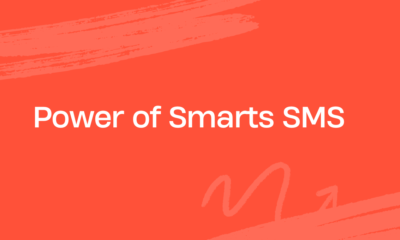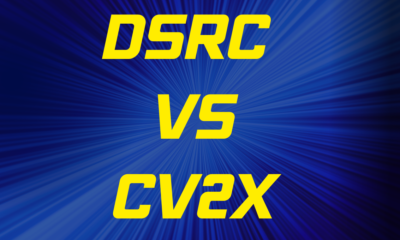Business Solutions
Optimize Broadcast Live Streams with Cellular Bonding
In the fast-paced world of live streaming, broadcasters constantly face the challenge of maintaining a stable and high-quality connection. Viewers demand seamless experiences, and even a slight hiccup can lead to a loss of engagement and credibility. Enter cellular bonding – a game-changing technology that promises to revolutionize how we broadcast live. By combining multiple network connections, cellular bonding ensures superior reliability and pristine streaming quality, even in challenging environments. Imagine reaching wider audiences without the worry of dropped signals or buffering interruptions. In this blog post, we delve into how cellular bonding can optimize your live broadcast, offering the perfect blend of dependability and excellence to captivate your audience like never before. Read on to discover the future of live streaming!
Published
9 months agoon
By
Marks Strand
The ability to broadcast live has become a crucial component of content delivery. From breaking news to live sports, concerts, and virtual events, the demand for high-quality, real-time streaming continues to grow. As the expectations for seamless live broadcasts increase, so does the need for reliable technology to support these broadcasts. One such technology that is transforming the way we broadcast live is cellular bonding for live streaming. This innovative solution is enhancing the stability, quality, and reliability of live streams, making it a game-changer for broadcasters around the world.
Understanding Broadcast Live
Broadcasting live refers to the real-time transmission of video and audio content to a remote audience over the internet or traditional broadcasting channels. Unlike pre-recorded content, live broadcasts are delivered instantaneously, allowing viewers to experience events as they happen. This immediacy and authenticity are what make live broadcasting so powerful and engaging.
To successfully broadcast live, several key components are required. These include high-quality cameras to capture the video, microphones for clear audio, encoding devices to convert the video into a streamable format, and a stable internet connection to transmit the content. Additionally, live streaming platforms, such as YouTube, Facebook Live, and Twitch, play a vital role in delivering the broadcast to the audience.
The challenge with live broadcasting lies in its unpredictability. Network issues, equipment failures, and other unforeseen problems can disrupt the stream, leading to poor viewer experiences. This is where cellular bonding for live streaming comes into play, providing a solution that significantly enhances the reliability and quality of live broadcasts.
The Role of Cellular Bonding in Live Streaming
Cellular bonding is a technology that combines multiple cellular connections to create a single, robust internet connection. By aggregating the bandwidth from several networks, cellular bonding provides greater reliability and higher upload speeds, which are essential for live streaming. This technology is particularly valuable in situations where traditional wired internet connections are either unavailable or unreliable.
In a broadcast live scenario, cellular bonding ensures that the stream remains stable even if one or more of the cellular networks experience issues. This redundancy is crucial for maintaining a consistent and high-quality broadcast, especially in environments with fluctuating network conditions. Cellular bonding effectively eliminates the risk of stream interruptions caused by network instability, making it an indispensable tool for live streaming.
Moreover, cellular bonding is highly portable and flexible, allowing broadcasters to go live from virtually any location. Whether it’s a remote area, a crowded urban center, or a moving vehicle, cellular bonding enables reliable live streaming without the need for extensive infrastructure.

Advantages of Using Cellular Bonding for Live Streaming
The primary advantage of using cellular bonding for live streaming is the increased reliability it offers. By combining multiple cellular networks, broadcasters can ensure that their live stream remains uninterrupted, even if one network fails. This redundancy is especially important for critical live broadcasts, such as news reporting or sports events, where any disruption can lead to significant viewer dissatisfaction.
Another key benefit is the improved quality and stability of the broadcast. Cellular bonding provides higher upload speeds by aggregating bandwidth, which translates to better video resolution and fewer buffering issues. Viewers expect high-definition streams with minimal lag, and cellular bonding helps deliver on these expectations.
Cost-effectiveness is another advantage of cellular bonding. Setting up a traditional wired connection in remote or temporary locations can be expensive and time-consuming. Cellular bonding, on the other hand, requires only portable equipment and SIM cards from multiple carriers, making it a more affordable and practical solution for many live streaming scenarios.
How Cellular Bonding Works in a Broadcast Live Setup
The technology behind cellular bonding is both sophisticated and user-friendly. At its core, cellular bonding works by splitting the data from a live stream into smaller packets and sending them across multiple cellular networks. These packets are then reassembled at the destination to create a seamless video stream.
To integrate cellular bonding into a broadcast live setup, broadcasters typically use a portable bonding device that supports multiple SIM cards. This device connects to the cameras and encoding equipment, aggregating the bandwidth from the different networks to create a single, stronger connection. The bonded connection is then used to transmit the live stream to the streaming platform.
The integration of cellular bonding with existing broadcast systems is straightforward. Most modern bonding devices are designed to work with standard live streaming equipment and platforms, allowing broadcasters to easily incorporate this technology into their workflows. Additionally, many bonding solutions come with user-friendly software that allows operators to monitor and manage the bonded connection in real-time.
Tips for Cellular Bonding in Live Broadcasts
To get the most out of cellular bonding in live broadcasts, consider the following best practices:
- Use Multiple Carriers: Ensure that your bonding device is equipped with SIM cards from different carriers. This increases the chances that at least one network will be strong enough to support the stream, even in challenging environments.
- Optimize Stream Settings: Adjust your stream’s resolution, bitrate, and frame rate to match the available bandwidth. This helps prevent buffering and ensures a smoother viewing experience for your audience.
- Monitor the Connection in Real-Time: Use the management software provided with your bonding device to keep an eye on network performance. This allows you to make adjustments on the fly, ensuring that your broadcast remains stable.
- Have a Backup Plan: Even with cellular bonding, it’s wise to have a backup connection available, such as a satellite link or a secondary bonding device. This ensures that you can continue broadcasting in case of unexpected issues.
- Regularly Test Your Setup: Before going live, thoroughly test your equipment and connection in the environment where you’ll be broadcasting. This helps identify any potential issues and ensures that everything runs smoothly when it’s time to go live.
Real-World Applications of Cellular Bonding
Cellular bonding has been successfully used in a variety of live broadcasting scenarios. One notable example is live news reporting from remote or conflict areas. In such environments, traditional wired connections are often unavailable, and the cellular networks may be unstable. Cellular bonding provides the necessary reliability and bandwidth to ensure that news organizations can broadcast live updates without interruptions.
Another application is in live sports broadcasting. Sporting events often take place in large venues or outdoor locations where network conditions can be challenging. Cellular bonding allows broadcasters to maintain a stable stream, ensuring that viewers can enjoy the action in real-time without buffering or drops in quality.
Entertainment events, such as concerts and festivals, have also benefited from cellular bonding. These events typically attract large crowds, leading to network congestion. Cellular bonding overcomes this issue by combining multiple networks, providing the necessary bandwidth to stream the event live to audiences worldwide.
Future Trends in Broadcast Live and Cellular Bonding
The future of broadcast live and cellular bonding looks promising, with several emerging trends set to enhance the capabilities of this technology. One of the most significant trends is the rollout of 5G networks. 5G offers much faster speeds and lower latency than current 4G networks, which will further improve the performance of cellular bonding for live streaming. With 5G, broadcasters can expect even higher video quality, more stable connections, and the ability to stream from more locations than ever before.
Another trend is the integration of AI and machine learning into cellular bonding devices. These technologies can optimize network usage in real-time, automatically adjusting settings to ensure the best possible stream quality. AI can also help predict network performance, allowing broadcasters to proactively address potential issues before they impact the live stream.
Remote production is also becoming more prevalent, driven by advances in cellular bonding technology. Broadcasters can now produce live events from a central location while the cameras and other equipment are deployed remotely. This reduces the need for on-site crews and equipment, lowering costs and increasing flexibility.
Cellular bonding for live streaming has revolutionized the way we broadcast live, offering unparalleled reliability, quality, and flexibility. As the technology continues to evolve, with advancements such as 5G and AI, cellular bonding will only become more integral to live broadcasting. By understanding how to effectively implement and maximize cellular bonding in their broadcasts, content creators and broadcasters can ensure that they deliver seamless, high-quality live streams that meet the ever-increasing expectations of their audiences. Whether you’re streaming from a remote location, a crowded venue, or on the move, cellular bonding provides the tools you need to broadcast live with confidence and clarity.
FAQs for Broadcast Live Streaming and Cellular Bonding
- What is cellular bonding for live streaming?
Cellular bonding is a technology that combines multiple cellular connections to create a single, robust internet connection. This ensures a stable and reliable live stream, even in areas with poor or fluctuating network conditions.
- How does cellular bonding improve broadcast live streaming?
Cellular bonding enhances broadcast live streaming by providing increased reliability, higher upload speeds, and better video quality. It does this by aggregating bandwidth from multiple cellular networks, reducing the risk of stream interruptions and buffering.
- What are the key components needed to broadcast live?
To broadcast live, you need high-quality cameras, microphones, encoding devices, a stable internet connection, and access to a live streaming platform like YouTube, Facebook Live, or Twitch.
- Why is cellular bonding particularly useful for remote live broadcasts?
Cellular bonding is ideal for remote live broadcasts because it doesn’t rely on traditional wired internet connections, which may be unavailable or unreliable in remote locations. It allows broadcasters to go live from virtually anywhere with a cellular signal.
- What challenges can arise when using cellular bonding for live streaming?
Challenges include variability in cellular network performance, potential high data usage costs, and the need for compatible equipment. These can be managed by using multiple carriers, optimizing stream settings, and monitoring the connection in real-time.
- How does 5G technology impact cellular bonding for live streaming?
5G technology significantly improves cellular bonding by offering faster speeds and lower latency compared to 4G. This leads to better video quality, more stable connections, and the ability to stream from more locations with less network congestion.
- What are the advantages of using cellular bonding over traditional wired connections?
Cellular bonding offers greater flexibility, portability, and redundancy compared to traditional wired connections. It is particularly useful in environments where wired connections are impractical, expensive, or unavailable.
- How do broadcasters integrate cellular bonding into their existing setups?
Broadcasters typically use a portable bonding device that supports multiple SIM cards. This device connects to the cameras and encoding equipment, aggregating bandwidth from different networks to create a single, stronger connection for live streaming.
- What are some real-world applications of cellular bonding in live broadcasting?
Cellular bonding is used in live news reporting, sports broadcasting, and entertainment events. It allows for stable, high-quality live streams in environments with challenging network conditions, such as remote areas or crowded venues.
- What tips can help maximize the effectiveness of cellular bonding in live broadcasts?
To maximize effectiveness, use SIM cards from multiple carriers, optimize stream settings, monitor the connection in real-time, have a backup plan, and regularly test your setup in the broadcasting environment.
You may like
Business Solutions
Geneo Glam: Skin Firming Treatment for Radiant, Youthful Skin
Geneo Glam is the ultimate skin firming treatment designed to restore elasticity, enhance radiance, and leave you with a glowing, youthful complexion.
Published
12 hours agoon
May 9, 2025By
Marks Strand
The Geneo Glam skin firming treatment is a luxurious, non-invasive facial that revitalizes the skin by improving firmness, elasticity, and hydration. Using advanced OxyPod technology, this treatment delivers a unique combination of exfoliation, oxygenation, and infusion of active ingredients to help the skin look smoother, tighter, and more radiant.
Key Benefits
- Firms and Hydrates
The treatment boosts collagen and elastin production, helping skin feel firmer and more supple. - Improves Elasticity
Increases the skin’s resilience and reduces the appearance of fine lines and wrinkles. - Prevents Collagen Breakdown
Helps preserve the skin’s youthful structure by protecting existing collagen and supporting healthy cell function.
Powerful Natural Ingredients
- 24K Gold Particles
Stimulate collagen production, protect skin fibers, and encourage cell renewal for a firmer, lifted appearance. - Silk Amino Acids
Strengthen the skin barrier, lock in moisture, and support collagen synthesis to reduce visible signs of aging. - Carnosine Peptides
Help protect the skin from sugar-related damage (glycation), delay cellular aging, and extend the life of skin cells. - Copper
An antioxidant and anti-inflammatory that supports collagen development, smooths fine lines, and helps with skin regeneration.
How the Treatment Works
- Exfoliation and Oxygenation
The Geneo Glam OxyPod is activated with a Primer Gel, gently exfoliating the skin and triggering a natural oxygenation process that increases blood flow and enhances skin vitality. - Infusion of Actives
Active ingredients such as gold particles, peptides, and amino acids are infused deep into the skin to firm and rejuvenate. - Hydration and Nourishment
A final serum containing hyaluronic acid, rosehip oil, and marula oil hydrates and soothes the skin, leaving it soft and glowing.
Who Should Try Geneo Glam?
This treatment is ideal for people who want to:
- Reduce fine lines and early signs of aging
- Firm and tighten sagging skin
- Restore hydration and improve skin tone
Geneo Glam offers a refreshing way to firm, lift, and hydrate your skin—leaving you with a youthful glow and smooth, resilient skin. It’s a perfect solution for anyone seeking visible results without invasive procedures or downtime.
Business Solutions
H.265 miniature UAV encoders: A comprehensive Overview
H.265 miniature UAV encoders revolutionize aerial technology with advanced video compression, ensuring high efficiency and superior performance for modern UAV systems.
Published
2 days agoon
May 8, 2025By
Adva
As the demand for high-quality, real-time video transmission from unmanned aerial vehicles (UAVs) continues to rise in both military and commercial applications, the need for efficient, compact video encoding solutions has become paramount. H.265 miniature UAV encoders represent a significant advancement in this space, providing robust video compression in a small, lightweight package ideal for drones with stringent size, weight, and power (SWaP) constraints. Leveraging the power of High Efficiency Video Coding (HEVC), also known as H.265, these encoders allow UAVs to deliver high-resolution video over constrained data links, enhancing situational awareness and operational effectiveness without overwhelming available bandwidth.
H.265 is a video compression standard that succeeds H.264/AVC and offers approximately double the data compression ratio at the same video quality level. This efficiency is particularly beneficial for UAV applications, where bandwidth and power availability are limited, especially during beyond-line-of-sight (BLOS) missions or in contested environments. With H.265 encoders, UAVs can stream 1080p or even 4K encoder video in real time while consuming significantly less data than older standards. This is critical for operations such as intelligence, surveillance, and reconnaissance (ISR), where maintaining video clarity over long distances or through relay networks is essential for accurate decision-making.
Miniature H.265 UAV encoders are engineered to operate under harsh environmental conditions while maintaining optimal performance. These devices are typically ruggedized, featuring extended temperature ranges, shock resistance, and electromagnetic shielding to ensure reliable operation in military or field environments. Despite their small size—often no larger than a deck of cards—they include advanced features such as low-latency encoding, dynamic bitrate control, encryption, and support for multiple streaming protocols including RTSP, RTP, and MPEG-TS. This allows them to integrate seamlessly into existing command-and-control infrastructure and support a variety of end-user applications, from real-time ground monitoring to autonomous navigation and object tracking.

The integration of H.265 encoders into small UAVs has significantly expanded the capability of tactical drone systems. For example, military units can deploy hand-launched drones equipped with these encoders to provide persistent ISR coverage over a battlefield, transmitting clear, actionable video intelligence back to command centers in near real time. Law enforcement agencies and border security forces also benefit from these technologies, using UAVs to monitor large or remote areas with minimal personnel. In disaster response scenarios, such encoders enable drones to deliver live aerial assessments of affected regions, helping responders prioritize actions and coordinate relief efforts efficiently.
Beyond video transmission, modern H.265 UAV encoders are increasingly integrated with onboard artificial intelligence modules that enable edge processing. This allows UAVs to perform real-time object recognition, motion detection, and scene analysis directly within the encoder, reducing the need to send raw data to centralized systems for processing. Such capabilities are crucial in time-sensitive missions where latency can affect outcomes, such as tracking moving targets or identifying threats in complex terrain.
Despite their many advantages, the deployment of H.265 miniature encoders does come with some technical considerations. The encoding process, while more efficient than previous standards, requires higher computational resources. Manufacturers must therefore strike a careful balance between processing power, thermal management, and energy consumption. Additionally, the compatibility of H.265 streams with legacy systems remains a factor, as not all ground stations or video players natively support HEVC decoding without updates or specialized software.
Manufacturers of H.265 miniature UAV encoders include companies such as IMT Vislink, Soliton Systems, Haivision, and VITEC, all of which provide solutions tailored to UAV and robotics applications. These encoders are often modular, allowing integrators to select configurations based on mission requirements, payload limitations, and transmission needs. As the ecosystem of compact, high-efficiency video systems grows, continued innovation in low-power silicon and AI integration is expected to drive the next wave of capability enhancements in this field.
In the evolving landscape of drone technology, H.265 miniature UAV encoders stand out as a critical enabler of high-performance video transmission. By combining advanced compression with minimal SWaP impact, these systems provide UAV operators with the tools to observe, analyze, and act with unprecedented precision and clarity—no matter how small the platform or how demanding the environment.
Business Solutions
IEEE 802.11p and V2X Communication: Enabling Smarter, Safer Roads
IEEE 802.11p revolutionizes V2X communication, driving smarter, safer roads through advanced vehicle connectivity. This cutting-edge technology enhances transportation systems, enabling intelligent and secure interactions for a safer future.
Published
2 days agoon
May 7, 2025By
Adva
Modern vehicles are no longer isolated machines; they are becoming intelligent, connected nodes within a larger transportation ecosystem. At the heart of this transformation is Vehicle-to-Everything (V2X) communication, which enables cars to talk to each other and to the infrastructure around them. One of the first and most influential technologies developed to support V2X is the IEEE 802.11p standard—a wireless standard specifically tailored for vehicular environments.
What is IEEE 802.11p?
IEEE 802.11p is an amendment to the IEEE 802.11 standard (commonly known as Wi-Fi), designed to enable wireless access in vehicular environments. It was approved in 2010 and forms the basis for Dedicated Short-Range Communications (DSRC).
Key Characteristics of 802.11p:
- Frequency Band: Operates in the 5.9 GHz band reserved for Intelligent Transportation Systems (ITS).
- Low Latency: Optimized for fast, real-time communication necessary for safety-critical applications.
- Range: Effective communication range of up to 1 kilometer, suitable for high-speed vehicle interaction.
- Decentralized Architecture: Enables direct communication (V2V and V2I) without the need for cellular or network infrastructure.
- Robustness: Handles high-speed mobility and rapidly changing topologies typical of vehicular environments.

Role of 802.11p in V2X Communication
V2X (Vehicle-to-Everything) is a broader term encompassing various communication paradigms, including:
- V2V (Vehicle-to-Vehicle)
- V2I (Vehicle-to-Infrastructure)
- V2P (Vehicle-to-Pedestrian)
- V2N (Vehicle-to-Network)
- V2C (Vehicle-to-Cloud)
802.11p primarily supports V2V and V2I communications, forming the backbone of DSRC-based V2X implementations. Its low latency and direct communication capabilities make it ideal for applications such as:
- Forward collision warnings
- Intersection movement assist
- Emergency electronic brake lights
- Lane change warnings
Comparison with Cellular V2X (C-V2X)
As V2X technology has evolved, C-V2X (based on LTE and 5G standards) has emerged as a strong alternative to 802.11p. Here’s how they compare:
| Feature | IEEE 802.11p (DSRC) | C-V2X (LTE/5G) |
| Latency | ~10 ms | ~5–10 ms (LTE), <5 ms (5G) |
| Coverage | Short-range, direct | Short + long-range via network |
| Deployment | Mature, field-tested | Growing, especially with 5G |
| Infrastructure | Minimal (no cellular needed) | Requires cellular networks (for V2N/V2C) |
| Interoperability | Limited with C-V2X | Newer versions support dual-mode |
Adoption and Use Cases
Global Deployment:
- United States: Initially favored DSRC based on 802.11p, though recent FCC rulings have shifted focus toward C-V2X.
- Europe: ETSI has defined ITS-G5, a protocol stack based on 802.11p.
- Japan and South Korea: Active use of DSRC for tolling and traffic safety.
Real-World Applications:
- Collision avoidance systems
- Smart intersections
- Road hazard notifications
- Platooning for commercial vehicles
- Public transport priority systems
Advantages of 802.11p
- Mature and Proven: Used in numerous pilot programs and early deployments.
- Fast Time to Communication: No need for handshake protocols; devices can communicate almost instantly.
- No Subscription Costs: Operates independently of cellular networks.
Limitations and Challenges
- Scalability: In high-density traffic, packet collisions may reduce reliability.
- Spectrum Allocation: Regulatory changes in some countries have limited the bandwidth available to DSRC.
- Limited Ecosystem Growth: Many automakers and countries are shifting investment to C-V2X and 5G-based platforms.
Future Outlook
While 802.11p has laid the foundation for V2X communication, the industry is gradually pivoting toward more advanced and scalable technologies such as 5G NR-V2X. However, 802.11p remains relevant in regions where DSRC infrastructure is already deployed and continues to serve as a dependable option for immediate, low-latency vehicular communication.
Hybrid Solutions:
Some industry players are exploring dual-mode V2X devices that support both 802.11p and C-V2X, ensuring backward compatibility and smoother transitions.
IEEE 802.11p has played a pivotal role in launching the era of connected vehicles, offering reliable, low-latency communication tailored for high-speed mobility. While newer technologies like C-V2X and 5G are beginning to dominate the roadmap, 802.11p’s contributions remain foundational in the evolution of V2X systems. As the automotive industry moves forward, a mix of technologies, including legacy support for 802.11p, will ensure that safety, efficiency, and connectivity continue to advance on roads around the world.

Geneo Glam: Skin Firming Treatment for Radiant, Youthful Skin

H.265 miniature UAV encoders: A comprehensive Overview

IEEE 802.11p and V2X Communication: Enabling Smarter, Safer Roads
Trending
-
Marketing & Analytics2 years ago
A Complete Guide To HubSpot’s New B2B Marketing, Sales Hub, and Prospecting Tool
-
3D Technology2 years ago
3D Scanner Technology for Android Phones: Unleashing New Possibilities
-
Marketing & Analytics2 years ago
How SMS Services And Software For Bulk SMS Sending Can Help Your Business Grow
-
3D Technology2 years ago
Mobile 3D Scanners: Revolutionizing 3D Scanning Technology
-
3D Technology2 years ago
3D scanning technologies and scanning process
-
Business Solutions1 year ago
Understanding A2P Messaging and the Bulk SMS Business Landscape
-

 Business Solutions1 year ago
Business Solutions1 year agoThe Power of Smarts SMS and Single Platform Chat Messaging
-

 Automotive2 years ago
Automotive2 years agoDSRC vs. CV2X: A Comprehensive Comparison of V2X Communication Technologies




